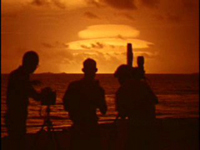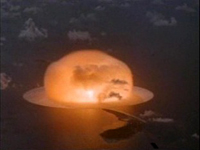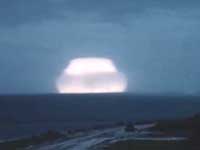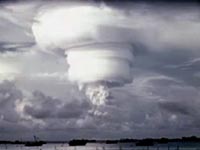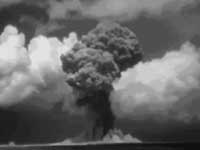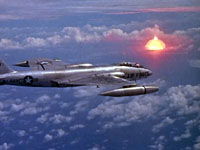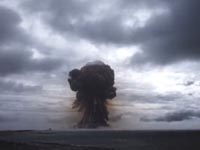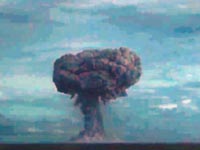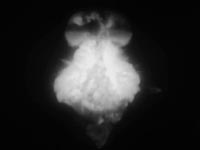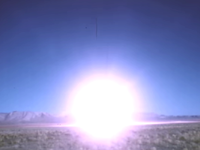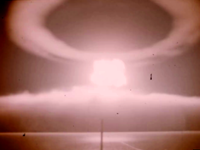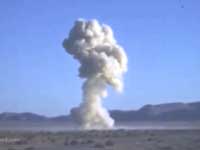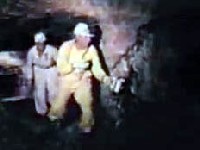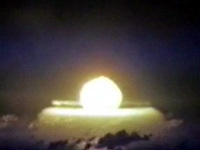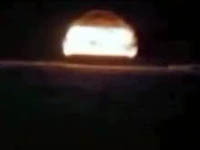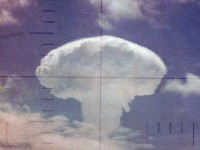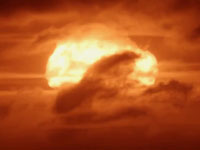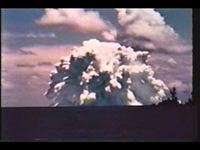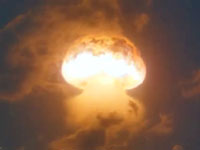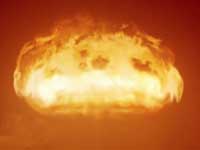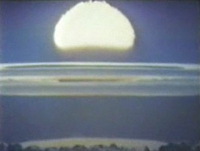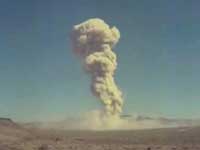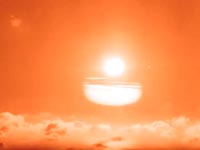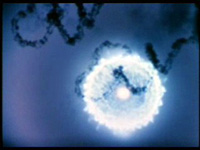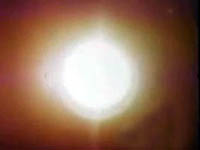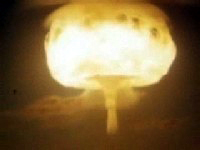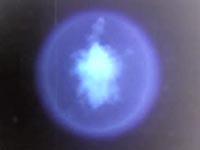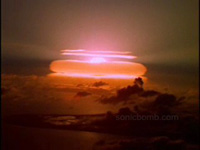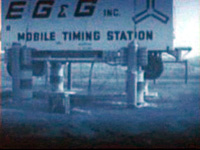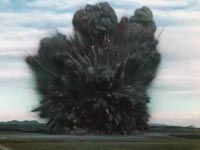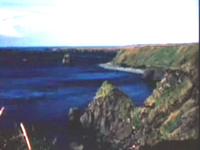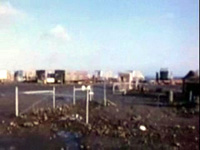 |
|
US Archive
|
Yucca - |Hardtack I|
|
Date: 02:40 UTC 28/04/1958
Type: Airburst @26210m
Yield: 1.7 Kt
Yucca was a joint DOD/LASL test of the W-25 air defense warhead in a high altitude balloon-lofted shot for ABM development work. The device including the baloon and payload weighed 345 kilos.
|
|
|
Cactus - |Hardtack I|
|
Date: 18:15 UTC 05/05/1958
Type: Surface
Yield: 18 Kt
LASL test of a MK-43 primary in a thermonuclear system mockup. Similar to to the Elder device. Predicted yield 13-14 kt. The Cactus device primary weighed 50 kg. The over all device weighed 650kg. and had a width of 45cm and a length of 175cm. The device was detonated 180 meters southwest of the Redwing Lacrosse crater. The Cactus crater had a diameter of 105 meters, and a maximum depth of 11 meters. The crater was used in 1979 as a burial pit to intern 85,000 cubic meters of radioactive soil and debris scraped from the various contaminated Enewetak Atoll islands. The 105 meter wide pit was capped with thick concrete forming a structure known as the Runit Dome. More information on the Runit Dome.
|
|
|
Koa - |Hardtack I|
|
Date: 18:30 UTC 12/05/1958
Type: Surface
Yield: 1.37 Mt
Koa was a test of the XW-35 which was designed from the outset as a thermonuclear warhead for the first generation of ICBMs. When accuracy of the Atlas ICBM was shown to be inferior to predictions, the XW-35 design was altered to give a higher yield. The predicted yield was 1.75 megatons; the actual yield was 1.37 megatons with the shortfall due to poor burning of the secondary. The fission yield was 750 kt. The W-35 was later dropped in favor of the W-49, a modification of the tried and trusted TX-28 from Operation Redwing. Shot Koa completely obliterated the Island Dridrilbwij aka Teiter. Clip used by kind permission of Atomcentral.com.
| |
|
Wahoo - |Hardtack I|
|
Date: 01:30 UTC 16/05/1958
Type: Underwater @-152m
Yield: 9 Kt
Wahoo was a deep water effects test using the Mk-7 bomb in 975m of seawater. The purpose
of this test (and Umbrella) was to improve the understanding of the effects of underwater
explosions on Navy ships and material. These were continuations of earlier underwater
tests that included Baker during operation Crossroads at Bikini in 1946 and Wigwam off the U.S. West Coast in 1955.
| |
|
Nutmeg - |Hardtack I|
|
Date: 21:20 UTC 21/05/1958
Type: Barge
Yield: 25 Kt
The second Bikini shot of Hardtack I, Nutmeg was detonated on a barge In the Zuni crater. Built by UCRL, it was a 2 stage thermonuclear device, possibly an XW-47 prototype. The predicted yield was 8-25 kilotons. Within 6 minutes the cloud had stabilized at 6,100 meters. clip used by kind permission of Atomcentral.com.
View 2
| View 3
| |
|
Sycamore - |Hardtack I|
|
Date: 03:00 UTC 31/05/1958
Type: Barge @3m
Yield: 92 Kt
Test of the 'Clean' TX-41 warhead similar to Poplar and Pine. The predicted yield was 5 Mt, but the fusion secondary failed to correctly ignite. The 92 kt yield was almost entirely from the fission primary.
| |
|
Umbrella - |Hardtack I|
|
Date: 18:15 UTC 08/06/1958
Type: Underwater @-30m
Yield: 8 Kt
Umbrella was a DOD sponsored weapons effects test for a medium depth underwater explosion. A Mk-7 bomb was used for the test (76cm diameter, 137cm long, device weight 374kg) in a heavy pressure vessel (total weight 3175kg). Very similar to the Wahoo device. The device was detonated on the lagoon bottom of Mut (Henry) Island. An underwater crater 914m across and 7m deep was produced.
| |
|
Oak - |Hardtack I|
|
Date: 19:30 UTC 28/06/1958
Type: Barge @1.8m
Yield: 8.9 Mt
A test of the LANL TX-46/53 device, Oak was one of the largest detonations at Enewetak Atoll. It was detonated on a barge moored on the reef 6.40 km southwest of Bokoluo Island. It was followed at noon by the Hickory shot at Bikini. The Initial height of the cloud was estimated to be 23,800 meters.
| |
|
Hickory - |Hardtack I|
|
Date: 00:00 30/06/1958
Type: Barge @3m
Yield: 14 Kt
Possible XW-47 primary test, similar to Hardtack II Neptune and Titania
| |
|
Poplar - |Hardtack I|
|
Date: 03:30 UTC 07/07/1958
Type: Barge
Yield: 9.3 Mt
Poplar was at least in part prompted by Hans Bethe's recommendations to President Eisenhower for a "clean" fusion weapon. Previous 'dirty' weapons had fission proportions of 50-77%, due to the use of U-238 as a 'pusher' around the lithium deuteride secondary stage. The 1956 'clean' tests used a lead or tungsten carbide pusher. Poplar was a test variant of the Mk-41C warhead, similar to Pine and Sycamore, it was the largest test of Hardtack I, and 5th largest U.S. test ever. Of it's 9.3 megatons yield, only 4.8% was fission, and thus was 95.2% "clean". The concept of a clean nuclear weapon is obviously largely political as this still equates to 450 kt of pure fission.
In the rapatronic clip vaporized parts of the bomb casing can be seen splashing against the inside of the expanding fireball. Article on rapatronic photography.
A smaller fireball can be seen being ejected from the top of the main fireball, seen also during Castle Romeo and Nectar. There is no known explanation for this phenomena. Clip used by kind permission of Atomcentral.com.
View 2
| View 3
| Rapatronic
| |
|
Juniper - |Hardtack I|
|
Date: 04:20 UTC 22/07/1958
Type: Barge @3m
Yield: 65 Kt
An exploratory shot by UCRL attempting to dramatically reduce the size and weight of a nominally 1 megaton warhead. UCRL weapons programmers from this period have described this test as the "most radical UCRL shot" and an "entirely new concept". This led eventually to the development of the W-47 Polaris missile warhead which considerably reduced the size of megaton class warheads. The degree of novelty can be judged by the range of predicted yields 0.2 kt to 60 kt, i.e. the possibility of complete failure of the boosted primary and the secondary stage was considered possible (0.2 kt is approximately the yield of a boosted primary that fails to boost). The test was a success. The device had a diameter of 36.5cm, and a length of 39cm. It weighed 67kg.
| |
|
Olive - |Hardtack I|
|
Date: 20:30 UTC 22/07/1958
Type: Barge @2.4m
Yield: 202 Kt
Concept feasibility test, a 2-stage thermonuclear device which established a high yield and light weight. Device weight was 100 kg producing a yield/weight ratio of 2 kilotons per kilo.
| |
|
Teak - |Hardtack I|
|
Date: 10:50 UTC 01/08/1958
Type: Airburst @76800m
Yield: 3.8 Mt
Teak was a high yield, high altitude test of the W-39 over Johnston Island during Operation Hardtack I and part of the anti-satellite 'Program 437'. The warhead was delivered to an altitude 77 kilometers by the tried and trusted US Army Redstone Rocket. Later tests during Operation Dominic used Thor missiles or modified Lockheed X-17 missiles. The purpose of the shot was to determine both feasibility of nuclear weapons as an anti-ballistic missile defense, as well as a means to defeat satellites and manned orbiting vehicles in space. Powerful EMP effects were experienced at Apia Observatory in Samoa and damaged land based electronics as far as 1500 km away.
Radiation became trapped by the Earth's magnetic field, creating artificial belts of radiation 100 to 1,000 times stronger than background levels.
|
|
|
Orange - |Hardtack I|
|
Date: 10:30 UTC 12/08/1958
Type: Missile @43000m
Yield: 3.8 Mt
Orange was an anti-ballistic missile system (ABM) effects test using a W-39 warhead launched on a Redstone ballistic missile. Of it's 3.8 Mt yield, 1.9 Mt was due to fission.
|
|
|
Fig - |Hardtack I|
|
Date: 04:00 UTC 18/08/1958
Type: Surface
Yield: 0.02 Kt
Probable XW-51 test. The shot was successful unlike the similar Quince shot that preceded it. It was the last atmospheric shot at Enewetak.
|
|
|
Dona Ana - |Hardtack II|
|
Date: 14:20 UTC 16/10/1958
Type: Balloon @150m
Yield: 0.037 Kt
Low yield Gnat device test, similar to shot Otero.
| |
|
Wrangle - |Hardtack II|
|
Date: 16:50 UTC 22/10/1958
Type: Balloon @460m
Yield: 0.115 Kt
Full yield test fizzle using an XW-47 primary, similar to Vesta, Oberon and Sanford
| |
|
Rushmore - |Hardtack II|
|
Date: 23:40 UTC 22/10/1958
Type: Balloon @150m
Yield: 0.188 Kt
Full yield test of XW-47 primary, similar to tests Vesta, Oberon and Wrangell. Developed by UCRL, the device was suspended from a balloon 460m above the Frenchman Flat NTS. At shot-time the winds were light and variable up to 1500m. The cloud reached a height of 8000m and moved to the northeast. DOD personnel took part in two scientificand diagnostic experiments, one conducted by the DOD Effects Test Group and the other by the UCRL.
| |
|
Sanford - |Hardtack II|
|
Date: 10:20 UTC 22/10/1958
Type: Balloon @460m
Yield: 4.9 Mt
Full yield test of XW-47 primary, similar to tests Vesta, Oberon and Wrangell. Developed by UCRL, the device was suspended from a balloon 460m above the Frenchman Flat NTS. At shot-time the winds were light and variable up to 1500m. The cloud reached a height of 8000m and moved to the northeast. DOD personnel took part in two scientificand diagnostic experiments, one conducted by the DOD Effects Test Group and the other by the UCRL.
Rapatronic
| |
|
Humboldt - |Hardtack II|
|
Date: 14:45 UTC 29/10/1958
Type: Tower @10m
Yield: 0.0078 Kt
Repeat of the earlier Hamilton device which fizzled, but with higher yield. An XW-51
Davy Crockett (Quail device) prototype, it was an extremely small device at only 16 kg.
View 2
| |
|
Operation Plowshare
|
Date: 1961-73
Type: Subsurfce
Total Yield: 717 Kt
Project Plowshare was the overall term for the development of techniques to use nuclear explosives for peaceful construction purposes, A.K.A. Peaceful Nuclear Explosions (PNE). The phrase was coined in 1961, taken from Micah 4:3 ("And he shall judge among the nations, and shall rebuke many people: and they shall beat their swords into plowshares"). The Soviet Union had a similar program of testing titled Nuclear Explosions for the National Economy. Proposed uses included widening the Panama Canal, constructing a new sea-level waterway through Nicaragua nicknamed the Pan-Atomic Canal, cutting paths through mountainous areas for highways, and for connecting inland river systems. Other proposals involved blasting underground caverns for water, natural gas, and petroleum storage. Serious consideration was also given to using these explosives for various mining operations. In the end, Nuclear explosives have never been used for commercial engineering purposes in the United States, but the concept has been tested.
| |
|
Gnome - |Nougat|
|
Date: 12:10 UTC 10/12/1961
Type: Subsurface @-360m
Total Yield: 3.1 Kt
Shot Gnome was fired in an underground salt dome formation. A permanent stable cavity 52 meters in diameter, and 24 meters high, was formed. This one of the very few nuclear test cavities (perhaps the only one) to avoid collapse. Some radiation accidentally released as a result of subsequent drilling.
| |
|
Aztec - |Dominic I|
|
Date: 16:01 UTC 27/04/1962
Type: Airdrop @796m
Yield: 410 Kt
This was a successful LASL test of the the XW-50X1-Y3 in a Mk-39 Mod-1 Type 3 drop case. It was the highest yield variant of the W-50 warhead (used on the Nike Zeus and Pershing missiles), giving a yield-to-weight ratio of 2.21 kt/kg. This device used a spherical secondary stage. The device was similar to those tested in Adobe, Kingfish, and Bluegill Triple Prime. The yield was slightly lower than expected. The mushroom cloud rose to about 18,300 meters.
| |
|
Arkansas - |Dominic I|
|
Date: 18:02 UTC 02/05/1962
Type: Airburst @1533m
Yield: 1090 Kt
The U.S.S.R had broken the 34 month testing ban on 1st September 1961 by undertaking a
large series of atmospheric nuclear tests, the U.S. responded with its own series of
tests. Arkansas was the first parachute-retarded device to be dropped at Christmas Island, it missed its intended air zero point by 183m, the mushroom cloud rose to about 18,288m. Proof-test of the LRL X-56 warhead, later deployed on the Minuteman missile. This warhead was similar to the W-47 deployed on the Polaris missile. The W-56 had the same yield as the high-yield variant of the W-47 (1.2 megatons), but weighed 60kg less. clip used by kind permission of Atomcentral.com.
| |
|
Questa - |Dominic I|
|
Date: 19:05 UTC 04/05/1962
Type: Airburst @1594m
Yield: 670 Kt
Questa was a LASL test of the XW-59 warhead in a Mk-39 Mod-1 Type 3 drop case. The W-59 was a development of the J-21 warhead design and was a competitor with the LRL W-56 to arm the Minuteman I missile. It was also intended for the Skybolt air-launched ballistic missile. The device was similar to those tested in Alma, Rinconada, and Sunset. The yield (expected to be 1 Mt) was considerably lower than expected (the full yield was later achieved in Sunset). The yield-to-weight ratio of 2.68 kt/kg was still quite respectable. The mushroom cloud rose to 18,900 meters. with a base height of 10,700 meters. In the end both the W-56 and W-59 were produced for the Minuteman I.
| |
|
Frigate Bird - |Dominic I|
|
Date: 23:30 06/05/1962
Type: High Altitude @3352m
Yield: 600 Kt
Frigate Bird was the only US test of an operational ballistic missile with a live warhead. This test involved firing a Polaris A1 missile from a ballistic missile submarine. The missile was launched by the USS Ethan Allen (SSBN-608) at 13:18 (local) from a position 1500 nm east-northeast of Christmas Island. The re-entry vehicle (RV) and warhead flew 1020 nm downrange toward Christmas Island before re-entering the atmosphere 12.5 minutes later, and detonating in an airburst at 3352 meters. The system tested was a combination of a Polaris A1 SLBM, and a W-47Y1 warhead in a Mk-1 RV. The Mk-1 RV had a beryllium heat-sink heat shield, and with the 325kg warhead had a gross weight of 408kg. The missile/RV demonstrated an accuracy on the order of 2011 meters.
| |
|
Yukon - |Dominic I|
|
Date: 18:01 UTC 08/05/1962
Type: Airbust @878m
Yield: 100 Kt
LRL parachute retarded test of the Calliope II device. This was an experimental shot, the first of a planned family of light weight, high-fusion/low-fission devices which were intended to increase the yield-to-weight ratio of ICBM warheads. The device was similar to those tested in Muskegon, Chetco, Nougat Arikaree, Hudson, Codsaw, and Hoosic. The yield was slightly higher than expected, the mushroom cloud rose to 17,373 meters.
View 2
| |
|
Muskegon - |Dominic I|
|
Date: 15:37 UTC 11/05/1962
Type: Airburst @913m
Yield: 50 Kt
Advanced lightweight low fission concept, similar to Chetco and Yukon, slightly lower than expected yield. Eight B-57S Sampled the cloud at altitudes from 10,700 to 17,100 meters.
| |
|
Swordfish - |Dominic I|
|
Date: 20:02 UTC 11/05/1962
Type: Subsurface @-198m
Yield: ≤ 20 Kt
A test of the ASROC anti-submarine rocket weapon system. The ASROC used the W-44
warhead, which had a nominal yield of 10 kt. It was a weapons effects test to evaluate
effects on ships, submarines, and sonar systems . A target array of four destroyers and a surfaced submarine were positioned at distances between 2011 and 4206 meters from surface zero. The ASROC was fired from the destroyer USS Agerholm (DD-826) at a target raft 3975m away. The rocket missed its sub-surface zero point by 18m and exploded at a depth of -198 feet in water that was 5224m deep. The spray dome from the detonation was 914m wide, and rose to 640m in 16 seconds. The detonation left a huge circle of foam-covered radioactive water.
View 2
| |
|
Yeso - |Dominic I|
|
Date: 17:01 UTC 10/06/1962
Type: Airburst @2537m
Yield: 3 Mt
Advanced concepts test of the 16-M device, similar to the Hardtack I Koa shot. The device performed as expected. clip used by kind permission of Atomcentral.com.
| |
|
Harlem - |Dominic I|
|
Date: 15:37 UTC 12/06/1962
Type: Airburst @4160m
Yield: 1.2 Mt
Parachute-retarded LRL drop test of the W-47Y2 Polaris warhead in a Mk-36 drop case. This device used a Tuba thermonuclear secondary stage. The higher yield Y2 variant doubled the W-47Y1 yield, achieving a yield-to-weight ratio of 3.42 kt/kg. Main clip used by kind permission of Atomcentral.com.
View 2
| |
|
Bighorn- |Dominic I|
|
Date: 15:19 UTC 27/06/1962
Type: Airburst @3600m
Yield: 7650 Kt
This was a test of the LRL Cello I-C device in a Mk-36 drop case. An advanced concepts test geared toward increasing thermonuclear yield-to-weight ratios. The test was successful, producing the second largest yield of any Dominic shot and was the largest to date. The yield-to-weight ratio was 4.14 kt/kg. The mushroom cloud rose to 22,860 meters. The device was 116 cm wide, 244 cm long and weighed 1,847kg.
View 2
| |
|
Bluestone - |Dominic I|
|
Date: 15:21 UTC 30/06/1962
Type: Airdrop @1518m
Yield: 1.27 Mt
Bluestone was a parachute-retarded test of the XW-56X2 Prime device in a Mk-36 drop case. The device was dropped by a new crew on its first drop mission. The device was similar to that tested in Swanee and Arkansas. This test achieved the full design yield for the W-56 warhead. The mushroom cloud rose to 17,678m. First clip used by kind permission of Atomcentral.com.
View 2
| |
|
Sedan - |Storax|
|
Date: 17:00 UTC 06/07/1962
Type: Subsurface @-190m
Yield: 104 Kt
The test was conducted under the auspices of the Plowshare program, which was an attempt
to develop non-military uses for nuclear explosives. The purpose of Sedan was to
investigate the potential of "clean" thermonuclear devices for producing large craters cheaply (for canal or harbor construction for example). Sedan was detonated at what was estimated to be the optimal crater depth in alluvial soil. 12 million tons of soil and rock were lifted into the air, 8 million tons of it falling outside the crater. The final crater was 390m wide and 97m deep. The force of the detonation released seismic energy equivalent to an earthquake magnitude of 4.75 on the Richter Scale. The program was abandoned due to unworkable residual radiation levels. Clip used by kind permission of Atomcentral.com. | |
|
Starfish Prime - |Fishbowl|
|
Date: 09:00 UTC 09/07/1962
Type: High Altitude @399Km
Yield: 1.4 Mt
This was the second attempt to launch the Starfish test. The original Starfish missile engine cut out and the range safety officer sent the destruct signal to the warhead destroying the warhead without producing nuclear yield. Large pieces of the missile fell back on Johnston Island causing heavy contamination. Starfish Prime was successful. The Thor missile carried the W-49 warhead/Mk-4 RV payload to 399km. The test was spectacularly visible from Hawaii 1280km and Kwajalein 2570km away, with impressive light displays from artifical aurora lasting up to 7 minutes. The EMP from the test disrupted power line in Oahu, knocked out street lighting, blew fuzes and circuit breakers, and triggered burglar alarms. The W-49 warhead used in this test was used on the Thor, Atlas, Jupiter, and Titan missiles, and was a descendant of the versatile Mk-28 thermonuclear bomb.
| |
|
Sunset - |Dominic I|
|
Date: 16:33 UTC 10/07/1962
Type: Airdrop @1500m
Yield: 1 Mt
Sunset was a high yield test of the XW-59 warhead in a Mk-15 drop case. This test successfully reached the full design yield of the W-59. This device was similar to those tested in Questa, Alma, and Rinconada. The mushroom cloud rose to 18,288m.
View 2
| |
|
Pamlico - |Dominic I|
|
Date: 15:37 UTC 11/07/1962
Type: Airdrop @43700m
Yield: 3.88 Mt
A parachute-retarded device in a MK-36 drop case. This was a test of advanced principles for
achieving high-efficiency thermonuclear burn, and successfully confirmed theoretical predictions. This was the last Christmas Island airdrop, and the third largest test of Operation Dominic.
| |
|
Johnny Boy - |Sunbeam|
|
Date: 16:45 UTC 11/07/1962
Type: Artillery @-0.6m
Yield: 0.5 Kt
W30 Mod 4 Y2 TADM (Tactical Atomic Demolition Munition) test, similar to Plumbbob Stokes. A cratering
weapon effect test, some venting was detected off site.
| |
|
Little Feller 1 - |Sunbeam|
|
Date: 17:00 UTC 17/07/1962
Type: Artillery @12m
Yield: 0.018 Kt
The M-388 Davy Crockett was a 155mm tactical nuclear recoilless rifle with a range of 4Km.
One of the smallest nuclear weapons ever fielded, developed in late 1950 for use against Soviet
troops in West Germany. The M-388 round used a W-54 warhead, a very small sub-kiloton fission device weighing about 23 kg, with a selectable yield of 10 or 20 tons. The shell's greatest effect would have been its extreme radiation hazard. Even at a low yield setting, the M388 would produce an almost instantly lethal radiation dosage (<10,000 rem) within 150m, and a probably fatal dose (600 rem) within 400m. This was the last atmospheric test at the NTS, and was observed by Robert F. Kennedy.
View 2
| |
|
Androscoggin - |Dominic I|
|
Date: 16:18 UTC 02/10/1962
Type: Airdrop @3130m
Yield: 75 Kt
This LRL shot was intended to be a high yield design test, but a fizzled. The device tested was possibly a Ripple device. This was the first U.S. test were all of the test instrumentation was carried on aircraft. RC-121, C-130, KC-135, and AFSWC RB-52B aircraft were used. These same aircraft were used on all five Johnston Island airdrop tests. This shot was later retested successfully in Housatonic (yield 8.3 Mt). The mushroom cloud rose to 16460 meters. The device was 143cm wide, 328cm in length and weighed 3015kg.
| |
|
Checkmate - |Fishbowl|
|
Date: 07:30 UTC 20/10/1962
Type: High Altitude @147Km
Yield: 10 Kt
This was the second successful Operation Fishbowl shot. This was a test of the LASL
XW-50X1 warhead launched by a solid fueled XM-33 Strypi rocket using an Army Recruit
rocket booster stage. The warhead detonated at an altitude of 146Km, 65Km downrange from Johnston Island, and only 3 kilometers from the airzero point. Since the shot occurred above the atmosphere, a luminous fireball was not formed. Instead observers on the island at the moment of detonation saw a green and blue circular region surrounded by a blood red ring. This faded in less than a minute, and blue-green streamers and pink striations developed that lasted half an hour. | |
|
Bluegill TP -|Fishbowl|
|
Date: 09:59 UTC 26/10/1962
Type: Missile @48.2Km
Yield: 400 Kt
The Bluegill experiment used a W-50 warhead in a Mk-4 reentry vehicle (RV), launched by a Thor missile. The device was similar to those fired in Adobe, Aztec, and Kingfish. Bluegill Triple prime was preceded by 3 failed attempts. This fourth and finally successful launch resulted in a detonation at an altitude of 48.2 km, approximately 30km south-southwest of Johnston Island. This burst occurred low enough in the atmosphere for fireball formation to occur. Observers saw a brilliant white flash and noticeable heat pulse on bare skin. A slightly distorted bright moon-like sphere was seen, yellow at first, then gradually showing green, pink, and violet hues. Blue-purple streamers were formed. A bright glow persisted for 30 minutes, at times bright enough to read a watch face in the dark. The fireball was also seen in Hawaii.
| |
|
Housatonic - |Dominic I|
|
Date: 16:02 UTC 30/10/1962
Type: Airdrop @3700Km
Yield: 8.3 MT
Housatonic airdrop was the final nuclear weapon airdrop by the U.S. The device tested was a Ripple II in a Mk-36 drop case, and it was delivered with near-perfect accuracy (bombing error less than 30m). This was a repeat of the failed Androscoggin (which fizzled) and was spectacularly successful, resulting in the highest yield of the Dominic test series. The yield-to-weight ratio was 2.56 kt/kg.
Rapatronic
| Initial fireball
|
|
|
Kingfish - |Fishbowl|
|
Date: 11:10 UTC 01/11/1962
Type: Missile @96300m
Yield: 400 Kt
Kingfish was similar to Bluegill Triple Prime, a W-50 in Mk-4 RV launched by a Thor missile. Johnston Island observers saw a yellow-white, luminous circle with intense purple streamers for the first minute. A large pale-green patch appeared somewhat south of the burst and grew, becoming the dominant visible feature after 5 minutes. By H+1 the green had become dull gray, but the feature persisted for 3 hours. At Oahu a bright flash was observed and after about 10 seconds a great white ball appeared to rise slowly out of the sea and was visible for about 9 minutes. Photographed on XR film, released during the 1999 DoE Declassification Program under Hazel O'Leary. Clip used by kind permission of Atomcentral.com.
|
|
|
Tightrope - |Fishbowl|
|
Date: 06:30 UTC 04/11/1962
Type: High Altitude @21Km
Yield: 10 Kt
This was a DOD sponsored live test of the Nike Hercules air defense missile system. A
Nike Hercules missile, carrying the LASL designed W-31 air defense warhead, was launched
and detonated over Johnston Island. The W-31 came in four yield variants ranging from 1 to 40 kt, it is not known which was fired in this test. On Johnston Island an intense white flash, to bright to view even through high density goggles, was accompanied by a strong heat pulse. A yellow-orange disc formed, slowly changing to a purple toroid which faded from view after several minutes. This shot is usually regarded as the last U.S. atmospheric test. | |
|
Dominic I Medley
|
Date: 1962
Type: n/a
Yield: n/a
Dominic included 36 tests. The majority of the tests (29 airdrops) were weapons development tests, intended to evaluate advanced designs that the labs had been developing during the years of the moratorium and before. This clip contains footage of various colour corrected Dominic I shots. Clip used by kind permission of Atomcentral.com.
| |
|
Salmon - |Whetstone|
|
Date: 16:00 22/10/1964
Type: subsurface @-830m
Yield: 5.3 Kt
Salmon the 15th shot of Operation Whetstone, a series of 48 nuclear tests conducted in 1964 and 1965. These followed the Niblick series and was in turn followed by Flintlock. All but one of these blasts were conducted beneath the Nevada Test Site. Clip used by kind permission of Atomcentral.com. | |
|
Faultless - |Crosstie|
|
Date: 18:15 19/01/1968
Type: subsurface @-366m
Yield: 1 Mt
This shot at Tonopah Nevada, was intended to test environmental and structural effects
to determine the feasibility of larger tests in the area. The test was aptly named as it
resulted in a large amount of "faulting" and enlarging of existing natural fissures. Clip used by kind permission of Atomcentral.com.
| |
|
Schooner - |Bowline|
|
Date: 16:00 08/12/1968
Type: sub-surface @-111m
Yield: 30 Kt
Plowshare - excavation experiment in hard dry rock.
| |
|
Milrow - |Mandrel|
|
Date: 22:06 02/10/1969
Type: subsurface @-1.22Km
Yield: 1 Mt
The purpose of the Milrow shot was to test Amchitka island, not a weapon. It was a "calibration shot", intended to produce data from which the impact of larger explosions could be predicted, and specifically, to determine whether the planned Cannikin shot could be performed safely. The shockwave reached the surface with an acceleration of over 35g, causing a dome of the earth's surface, approximately 3 km in radius, to rise about 5m. The blast "turned the surrounding sea to froth" and "forced geysers of mud and water from local streams and lakes 15 m into the air.
A subsidence crater was formed by material collapsing into the cavity formed by the explosion. | |
|
Cannakin
|
Date: 22:00 06/11/1971
Type: subsurface @-1.8Km
Yield: 5 Mt
Project Cannikin was a nuclear test conducted on Amchitka Island, Alaska, at 11:00 a.m., Bering Standard Time, on November 6, 1971. It was the largest underground nuclear test conducted in the United States, registering 7.0 on the Richter-scale and causing the ground to jump up by 5 meters. Cannikin was intended to test the design of the Spartan anti-ballistic missile (ABM) interceptor – a high-yield warhead that "produced copious amounts of x-rays and minimized fission output and debris to prevent blackout of ABM radar systems. The test would "measure the yield of the device, measure the x-ray flux and spectrum, and assure deployment of a reliable design. The test
caused huge amounts of damage to the coastline and was largely instrumental in the formation of Greenpeace. Clip used by kind permission of Atomcentral.com.
| |
|
|
 |





